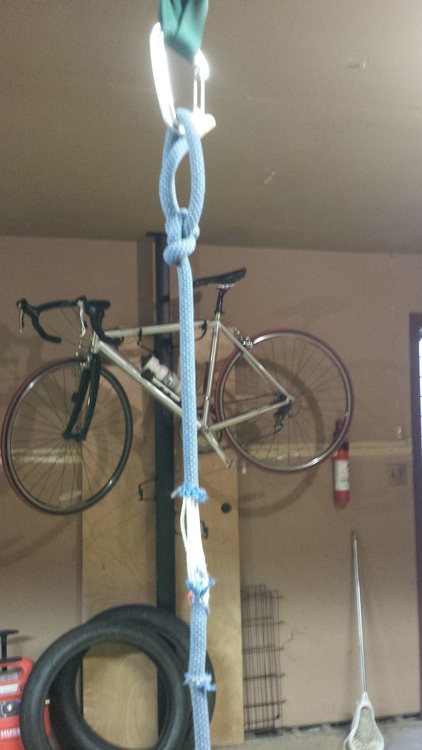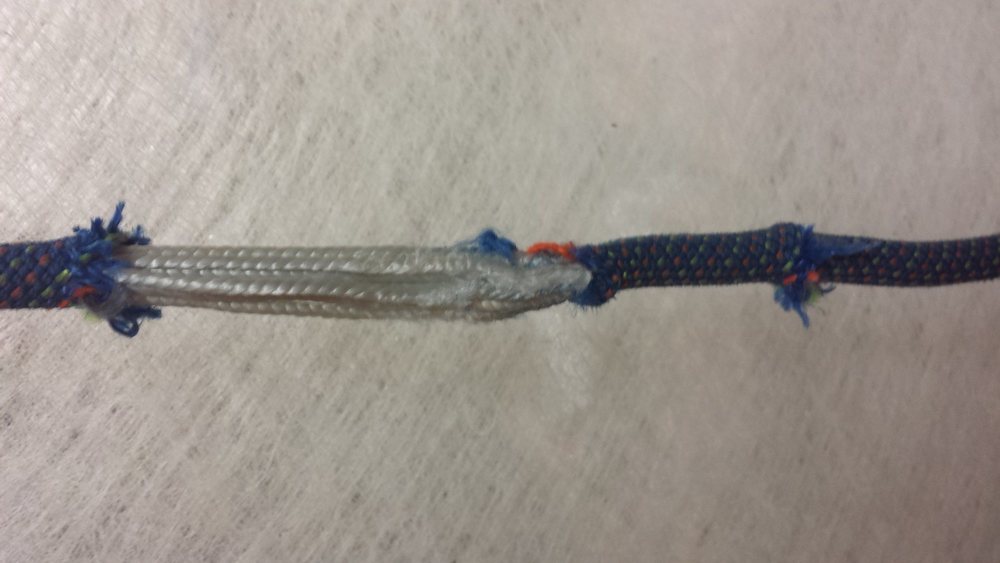Quick and dirty microtraxion drop test
|
|
Wanting to put my mind at ease about solo top-roping with a microtraxion, I decided to do a (poorly controlled) scientific experiment. Setup: 1) Visible core shot after 4 drops (all drops performed with the cam on the same spot on the rope). 2) Moved the microtraxion up 3 inches. 3) Visible core shot after 4 more drops (all on same spot on rope). 4) Sheath separated on the fifth drop. 5) Test was halted due to lack of a boulder pad. 6) No visible effects on micro-traxion. Conclusions: 1) Yer gonna die! 2) Have a backup device: there are a couple failure modes, such as a piece of clothing getting sucked into the device between the teeth and rope. 3) Assertions of "Sharp teeth! OMG, It'll cut the rope!" are just that: assertions. 4) If it makes you feel better, tie a knot somewhere in the rope to prevent a cut sheath from sliding all the way off the core. 5) My comfort with micro-traxions was satisfied by these test results. * Note on fall factor: the fall forces were increased by the doubled section of rope in the knot, but decreased by biner flex, webbing stretch, wooden beam flex, and my squishy giblets. |
|
|
A fall factor of 1 seems a bit extreme for a top rope solo fall. I suppose it is possible if you were climbing up and the rope didn't feed. For what it's worth, I tie the Traxxion directly into the tie in loops using webbing. This allows for the Traxxion to be oriented directly in line with the body and not have any slop in the rigging. I didn't like attaching the Traxxion using a carabiner. It didn't seem to feed as smoothly, and if you fell, the slop in the system would shock load the rope a bit too much for my taste. |
|
|
Thanks for posting doak. |
|
|
I suspect many folks set up a solo TR with the rope anchored below the edge, as you would do for a conventional TR. Rope running over the edge is to be avoided, right? But if you then top out above this powerpoint, a very large FF fall could result. Like FF way above 2. Since in solo TR'ing the rope isn't significantly moving over the edge, I tend to anchor my solo TR's well back from the edge e.g. up in the trees. Pad the edge as needed and it's all good. |
|
|
I don't do it that way at, Gunkiemike. I usually have an anchor for the two traxions and two lines, and then a couple of slings hanging down below the anchor, which I clip into before reaching the anchor as I approach it. When I'm done I rap off. |
|
|
Gunkiemike wrote:I suspect many folks set up a solo TR with the rope anchored below the edge, as you would do for a conventional TR. Rope running over the edge is to be avoided, right? But if you then top out above this powerpoint, a very large FF fall could result. Like FF way above 2. Since in solo TR'ing the rope isn't significantly moving over the edge, I tend to anchor my solo TR's well back from the edge e.g. up in the trees. Pad the edge as needed and it's all good.Say what? |
|
|
Gunkiemike wrote:I suspect many folks set up a solo TR with the rope anchored below the edge, as you would do for a conventional TR. Rope running over the edge is to be avoided, right? But if you then top out above this powerpoint, a very large FF fall could result. Like FF way above 2. Since in solo TR'ing the rope isn't significantly moving over the edge, I tend to anchor my solo TR's well back from the edge e.g. up in the trees. Pad the edge as needed and it's all good.I do exactly the same, Gunkiemike. Rope is anchored well back from the edge. Edge is padded as needed. But, if you were to anchor below the edge, top out over your powerpoint and fall I don't see the FF as over 2. Am I missing something? |
|
|
Getting a fall factor over 2 would require some extra-dimensional physics. I assume he meant a fall factor significantly over 1. |
|
|
One example of a fall factor 6 would be a 2 foot chain at the anchor and 1 foot of rope, climbing above it, and dropping. But we're getting nerdy at that point. |
|
|
teece303 wrote:Getting a fall factor over 2 would require some extra-dimensional physics. I assume he meant a fall factor significantly over 1.No, I think he actually meant >2. In the situation he is talking about you have a rope fixed below the edge of a cliff with static material above the edge. If you are soloing up on the trax you will climb up near the knot at the fixed rope, and in this potential scenario, if you were to climb up and over you could fall from above the point where the rope is fixed. When taking into account the length of fall on static material, this would result in a fall that is more than twice the length of (dynamic) rope. |
|
|
If that's what he meant then: don't use your traxion that way. |
|
|
Legion wrote:I guess lesson #1 of this test is to minimize slack and weight the traxion gently...Sure, you'll put less wear on the rope by being gentle, but my main take-away was that I don't need to be preoccupied by doubt while committing to hard moves. |
|
|
As per request, the knot that I use. I like the 1/2" webbing a little better but your preferences may be different. I have used this knot "alot" and found it to be super secure. As you will note, there is no slop in the system and it aligns the Traxxion at directly in front of the climber. |
|
|
Good thread, glad you started it Doak with your test.
|
|
|
Thanks Jim6565 |
|
|
Sirius wrote: To the poster with the vid/knot tying above, are you not worried about those loose rope ends in the vicinity of the mini?That's pretty much how I've tied on my ascender for the last 30 years when TR soloing. But, I usually tie it to my belay loop. What he shows is nothing more than a flat overhand knot. The cord passes through my ascender and harness 3 times. Each strand can only see 1/3 of the load. I use 7mm cord and the tails are usually about 6" long. I just tuck the tails under my harness and the ascender stays nice and close. I like this method better because with no carabiner there is no chance of crossloading. |

 Continue with onX Maps
Continue with onX Maps Continue with Facebook
Continue with Facebook





















